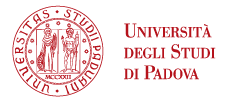Computational modelling of multiphysics coupled problems in civil nuclear and environmental engineering and geophysics
Francesco Pesavento francesco.pesavento@dicea.unipd.it
Lorenzo Sanavia lorenzo.sanavia@unipd.it
Carlo Peruzzo mailcarloperuzzo@gmail.com
Andrea Voltan andrea.voltan@dicea.unipd.it
Claudio Gavagnin gavagninclaudio@gmail.com
Francesco Pesavento 049 8275588
Lorenzo Sanavia 049 8275599
Research areas:
- Mathematical and numerical modeling of cementitious materials and geomaterials
In this research field, a general framework for the simulation of the non-linear coupled behavior of cementitious materials and geomaterials is developed. It is based on the Mechanics of multiphase porous media and in particular on TCAT (Thermodynamic Constrained Averaging Theory) which assures that the thermodynamics is properly taken into account at all scale-levels. The final form of the mathematical model is discretized at the macroscale by means of Finite Element Method or the Isogeometry Analysis. The resulting model is successfully applied to several engineering problems: evaluation of concrete's performance at early stages of maturing massive structures, structural repair works, concrete exposed to high temperature, e.g. during fire, cementitious materials subject to freezing/thawing cycles, leaching process and silica-alkali reactions (and the related mechanical effects), strain localization and failure in soils, thermo-hydro-mechanical consolidation, seismic/dynamic behavior of earth structures, slope instability and catastrophic landslides, etc. - Multiphysics modelling of strain localization and fracture
Strain localization and initiation and propagation of cracks in solids and structures are two of the most common problems in engineering with industrial applications. Strain localization may be precursor of fracture and failure and, together with crack initiation and propagation, are key issues in many multifield problems: they range from thermo-mechanical fracturing and cracks due to radiation or hydrogen embrittlement to fracturing induced by chemical effects or by fluid pressure variation under isothermal and non-isothermal conditions. This group is working on classical and recent approaches to fracture mechanics, such as linear elastic fracture mechanics, cohesive zone models, extended finite element methods (XFEM), remeshing techniques, enriched meshless methods (e.g. Peridynamics) and continuum based approaches to fracture simulation such as phase-field and non-local damage methods taking into account also the Self-Organised Criticality (SOC). For strain localization, regularized models for soils (visco-plastic and/or non-local constitutive models) are developed. - Radioactive waste disposal – Slope failure and landslides
In this research, the goal is to simulate, with a general model, different engineering problems such as the safety conditions of deep nuclear waste repositories or of natural slopes due to rainfall or earthquakes. In the first case, the thermo-hydro-mechanical behavior of concrete or bentonite barriers and argillaceous host material of deep nuclear waste disposal or the desiccation cracks in the excavation damaged zone and in the buffer material are studied. In the second case, the onset of landslides and catastrophic landslides is simulated. - Fire in tunnels
The final objective of this research is to simulate fire in tunnels from the combustion phase to the full development of fire, evaluating the resulting thermal fluxes which can stress the concrete structure (which is treated as a porous material). At this aim, an innovative parallel tool for the synchronization of CFD (Computational Fluid Dynamic) software and advanced code for the analysis of behavior of concrete structures exposed to high temperature has been developed.
Keywords: Non-isothermal Multiphase porous materials, advanced numerical analysis, damage and fracture, soils and concrete, fire and other severe conditions, dynamics, non-linear coupled problems, strain localization





